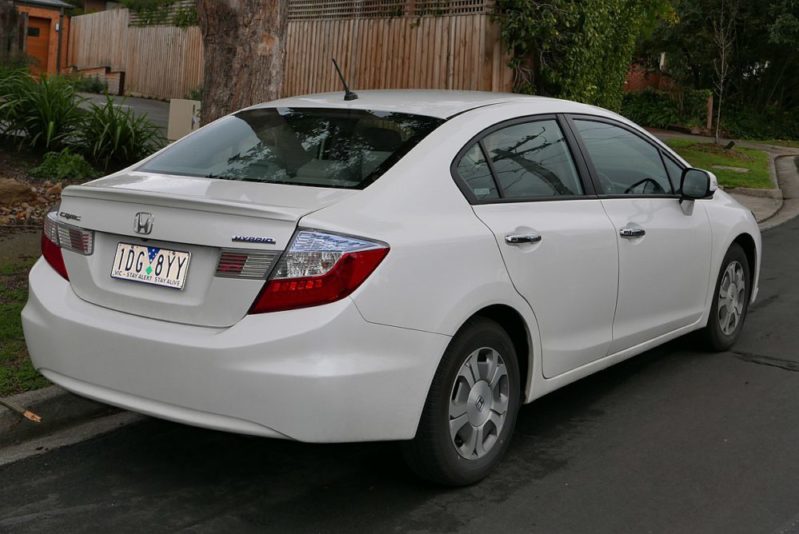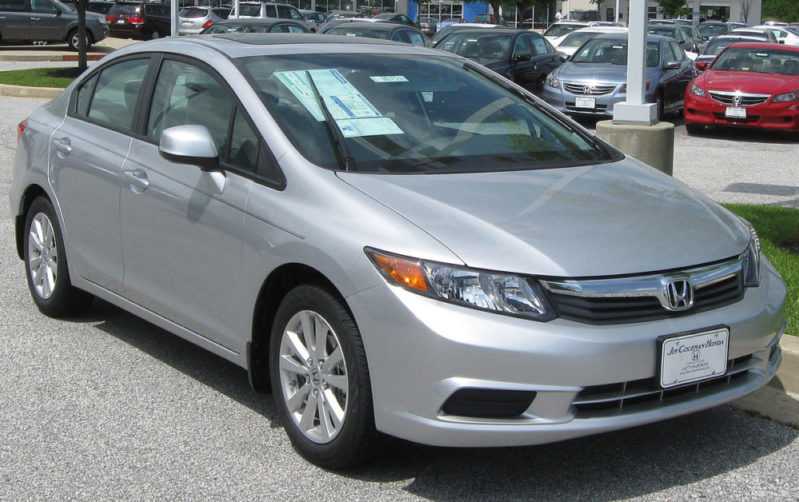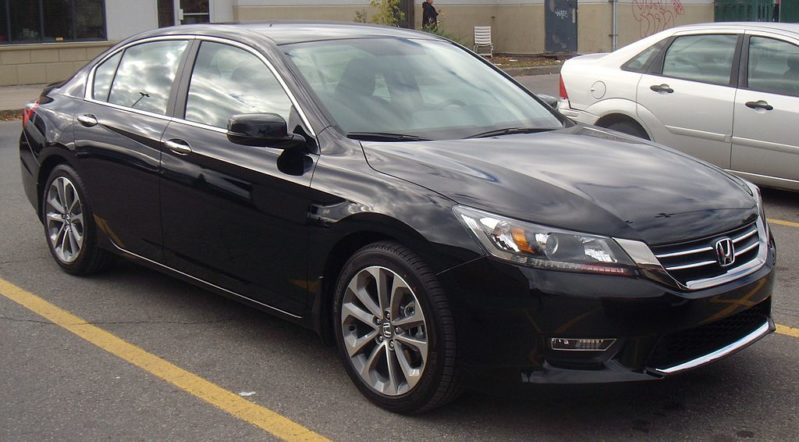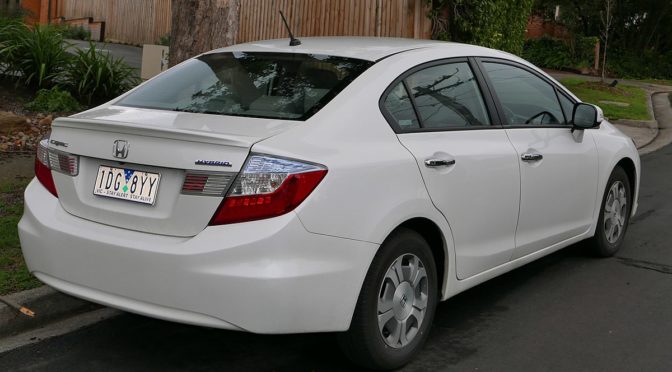
The IIHS recently released another round of calculations on the safest new vehicles by driver death rates. As always, I enjoy digging into the data and looking for trends. I do this with the standard disclaimers that a.) the margins of error are huge, and b.) vehicle safety is only one of three key components to auto best practices (the other two being driver behaviors and road and societal design). I recently wrote about how the Chevy Volt and Nissan Leaf were two of the safest electric / hybrid cars and two of the safest vehicles overall per the most recent DDR data available from the IIHS’ summer 2017 Status Report (volume 52, number 3). Last year I wrote about how the Toyota Prius was safer than a Chevy Tahoe, F-150 Super 4WD, and Toyota Sienna. Today we’ll take a look at how the Honda Civic fared in driver safety compared to its larger sibling, the Honda Accord.
2012-2014 Honda Civic (sedan)– 39 driver deaths (28-49)
 Per the IIHS, the estimated driver death rate during the 2012-2014 model years of the Honda Civic sedan was 39 with 27 of those deaths predicted to occur from multiple-vehicle collisions and 11 from single vehicle crashes, with 2 of those 11 crashes due to rollovers. The exposure came from 1,875,054 registered vehicle years. Essentially, the IIHS analyzed NHTSA records of vehicle deaths and IHS data of vehicle registrations and came up with a statistical model of how many fatalities one would expect from a certain number of drivers behind the wheels of ’12-’14 Civics. Per their calculations, if something like 1 million drivers drove 1 million ’12-’14 Honda Civics around the US for a year, we’d expect only 39 of them to die. It is noteworthy that the DDR for the coupe was only 10 with 7 multiple-vehicle deaths, 3 single vehicle deaths, an exposure of 286,756 registered vehicle years, and a confidence bound of 2-31.
Per the IIHS, the estimated driver death rate during the 2012-2014 model years of the Honda Civic sedan was 39 with 27 of those deaths predicted to occur from multiple-vehicle collisions and 11 from single vehicle crashes, with 2 of those 11 crashes due to rollovers. The exposure came from 1,875,054 registered vehicle years. Essentially, the IIHS analyzed NHTSA records of vehicle deaths and IHS data of vehicle registrations and came up with a statistical model of how many fatalities one would expect from a certain number of drivers behind the wheels of ’12-’14 Civics. Per their calculations, if something like 1 million drivers drove 1 million ’12-’14 Honda Civics around the US for a year, we’d expect only 39 of them to die. It is noteworthy that the DDR for the coupe was only 10 with 7 multiple-vehicle deaths, 3 single vehicle deaths, an exposure of 286,756 registered vehicle years, and a confidence bound of 2-31.
2013-2014 Honda Accord (sedan) – 36 driver deaths (22-50)
 In a statistically identical position to the Civic, we find the 2013-2014 Honda Accord sedan with a driver death rate of 36. Of those 36 estimated deaths, 21 were predicted to occur from multiple-vehicle collisions while 16 were predicted to occur through single vehicle crashes, with 9 of those 16 occurring during rollovers. The exposure came from 1,001,344 registered vehicle years, a slightly smaller figure than that of the Civic, which resulted in a larger confidence bound (spanning 28 instead of 21 with the Civic). As with the Civic, it’s important to note that the DDR does not mean that 36 drivers died driving that model range of the Accord. Rephrasing IIHS speak, the calculations mean that if 1 million drivers drove 1 million ’13-’14 Accords for a year, we’d expect 36 of them to die. It is noteworthy again to provide the coupe comparison numbers; here, the coupe Accord had a driver death rate of 20, with all 20 predicted deaths occurring in multiple vehicle collisions and an exposure of 101,5016 and confidence bound of 2-71.
In a statistically identical position to the Civic, we find the 2013-2014 Honda Accord sedan with a driver death rate of 36. Of those 36 estimated deaths, 21 were predicted to occur from multiple-vehicle collisions while 16 were predicted to occur through single vehicle crashes, with 9 of those 16 occurring during rollovers. The exposure came from 1,001,344 registered vehicle years, a slightly smaller figure than that of the Civic, which resulted in a larger confidence bound (spanning 28 instead of 21 with the Civic). As with the Civic, it’s important to note that the DDR does not mean that 36 drivers died driving that model range of the Accord. Rephrasing IIHS speak, the calculations mean that if 1 million drivers drove 1 million ’13-’14 Accords for a year, we’d expect 36 of them to die. It is noteworthy again to provide the coupe comparison numbers; here, the coupe Accord had a driver death rate of 20, with all 20 predicted deaths occurring in multiple vehicle collisions and an exposure of 101,5016 and confidence bound of 2-71.
How can the Civic be as safe as the Accord if it had a higher driver death rate?
This is where the margins of error I mentioned at the start of this article come into play. Although at first glance it would appear that the Accord sedan was a slightly safer vehicle to drive during the aforementioned model years than the Civic sedan due to a DDR of 36 vs a DDR of 39, we can’t just look at the single number; the confidence bounds provide a greater and ultimately more important context.
The 95% confidence bounds roughly describe the ranges in which we’d expect the true driver death rate to occur in 95% of samplings (scenarios with 1 million drivers driving the 1 million vehicles for one year). The Civic sedan’s bounds (28-49) and the Accord’s (22-50) overlapped significantly; only 22-27 and 50 did not, or 7/29, or 24%. This means there was a 76% chance both vehicles shared the same true driver death rate. So while it’s possible one vehicle was actually safer than the other, the odds are much greater that the differences in the DDRs were simply due to chance. In fact, statistically, we can’t say that the differences weren’t due to chance.
Does this mean a Civic is as safe of a vehicle for my son/daughter/husband/wife/children/family as an Accord?
In a word, yes. Despite the Accord being a larger and more expensive vehicle than the Civic, in actual driving safety as measured by the most accurate and ultimately important tests we have–records of who lived and who died on the roads–there wasn’t a significant difference in survivability between the two vehicles. It’s important to note that the IIHS only examined driver data, rather than data for any passengers (including children). However, given the fact that both vehicles have the same core safety features (i.e., good frontal and side crash scores, side airbags with head protection, and ESC), it’s likely they’d provide the same protection to passengers as they did to their drivers. A Civic is a great family vehicle. An Accord is a great family vehicle. We’ve long reached the point in the US where the vehicles themselves are safe enough; what’s lacking is how we’re driving them and where.
How do I keep my family safe, regardless of which vehicle I’m driving?
Remember that vehicle safety is only one third of the three factors that lead to auto safety. Driving safely and driving on safe infrastructure will make far more of a difference than vehicular choice, and neither of those options cost money; they just require good judgment. Choose safe speeds, follow best practices with car seats, and choose safe roads, and you’ll reduce your odds of your family’s involvement in a crash (and increase your odds of your family’s surviving a crash) more than you will by choosing any vehicle at any price.
It’s much harder to drive safely on a consistent basis by following best practices than it is to simply hope for the best by choosing a newer vehicle, but there isn’t a vehicle on the market that will compensate for poor driving or for poor infrastructure, and we have the ability to cut our risks of death immensely each time we get into our vehicles by simply driving the way the way we would if we were trying to earn our driver’s license–every single time we turned the key.
—
If you find the information on car safety, recommended car seats, and car seat reviews on this car seat blog helpful, you can shop through this Amazon link for any purchases, car seat-related or not. Canadians can shop through this link for Canadian purchases.

